
Original Link: https://www.anandtech.com/show/2660
Although the past 3-4 months have seen plenty of verbal abuse thrown towards NVIDIA developed chipsets, EVGA has thrown caution to the wind and released an updated 790i based motherboard known as the 790i FTW. To clarify, the FTW (For the Win) naming suffix merely denotes a more extreme version of the earlier released NVIDIA reference 790i Ultra SLI motherboard. The main "improvements" are centered around the Volterra VT115 PWM controller, solid capacitors throughout, 3x PCI-E 2.0 slots, onboard power/reset and CMOS clear buttons, and a slew of increased voltage ranges to appease the demands of the extreme user community.
In order to stir the pot and encourage adoption, Peter Tan (Aka Shamino), who formerly worked at Foxconn, has been enlisted by EVGA to make their latest offering palatable for the niche extreme overclocking market. As a first task, this is no small undertaking for anyone regardless of prior credentials. With NVIDIA succumbing to pressure from Intel (by providing SLI licensing rights to the upcoming X58 chipset), it seems there's little reason for anyone to be looking at a short-term stopgap SLI mainboard - unless we factor in the cost of a new processor that the X58 chipset will require if you're moving up from an older platform.
It appears that Nehalem/Core i7 won't universally benefit gaming performance, but even with that small nugget of hope for the 790i FTW, we have to acknowledge that there are already plenty of SLI capable motherboards in the marketplace. Boards based on the 650i, 680i, 750i, and 780i are all perfectly capable of providing decent performance for SLI aficionados, at a lower cost than the 790i FTW. Nevertheless, the 790i FTW is available for those who must have the top NVIDIA chipset, and EVGA's solid reputation as a consumer friendly organization may inspire enough confidence for such users to take the plunge.
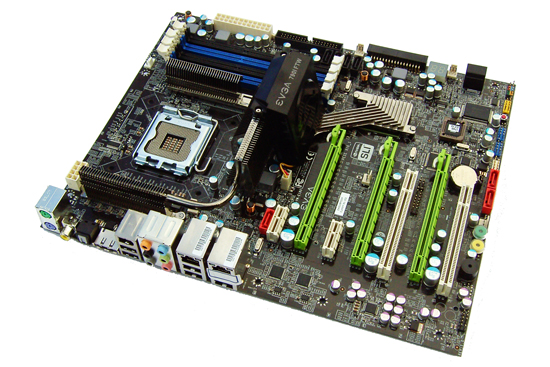 |
As the NVIDIA 790i reference boards have been in the marketplace for over six months now, our initial expectations for general peripheral compatibility on the 790i FTW are quite high. We'd expect that many of the faults highlighted by prolonged use of the reference design boards will now be ironed out, so these fixes can be transplanted directly into the backbone of the 790i FTW BIOS.
On the flipside, we already know there's a few things we need to look out for based our past experiences with the 790i SPP/MCP Northbridge/Southbridge combination. Specifically, there's the notorious potential for SATA OS drive corruption when the790i chipset is pushed to its limits. Of course, this can happen on any board and chipset if you get a little over zealous, but it seems the NVIDIA 6 and 7 series chipsets have been more susceptible to this issue than any other competing chipset. There's not really anything positive we can say about this situation other than the fact that boards based on these chipsets are usually best run in a conservative rather than aggressive manner. However, the FTW does beg to be pushed a little, so we're going to put our convictions aside while we do just that.
This won't be a hugely in depth review, as a very comprehensive 790i chipset overclocking guide has already been provided within our ASUS Striker II Extreme review. We'll briefly compare performance against some of the other enthusiast boards we've reviewed this year, and then perhaps throw caution to the wind and try our hands at a little sub-zero benchmarking. With all that said, let's move on to board specifications and features.
Board Layout and Features
| EVGA 790i FTW | |
| Market Segment | High End-Gaming & Benchmarking |
| CPU Interface | Socket T (Socket 775) |
| CPU Support | LGA775-based Core 2 Duo, Core 2 Extreme, or Core 2 Quad Recommended |
| Chipset | NVIDIA nForce 790i Ultra SLI SPP and MCP |
| Front Side Bus Speeds | Auto, CPU default to 700 in 1MHz increments |
| DDR3 Memory Speed | Auto, Linked and Unlinked |
| FSB Speeds | 1600/1333/1066/800 MHz |
| PCIe Speeds | Auto, 100MHz - 200MHz in 1MHz increments |
| SPP-to-MCP Link Speeds | Auto, 200-500MHz in 1MHz increments |
| HT Multipliers | 1x-5x for SPP-MCP and MCP-SPP |
| Core Voltage | Auto, 0.825V to 2.16V in 0.00625V increments |
| CPU Clock Multiplier | 6x ~ 11x, downward adjustable for Core 2, upward to 31 for Extreme |
| DRAM Voltage:DDR3 | Auto, 1.50V ~ 3.075V in 0.025V increments, 1.50V standard |
| DRAM Timing Control | Optimal, Expert (tCL, tRCD, tRP, tRAS, CPC, tRRD, tRC, tWR, tWTR, tFAW, tRFC and tREF) |
| DRAM Command Rate | Auto, 1T, 2T |
| NB Voltage | 1.30V - 1.57V in 0.05V increments |
| SB Voltage | Auto, 1.50V ~ 1.75V in 0.05V increments |
| CPU VTT Voltage | Auto, 1.10V ~ 1.625V in 0.075V increments |
| CPU PLL Voltage | 1.50V ~ 1.80V in 0.1V increments |
| CPU Vdroop Compensation | Enabled, Disabled |
| CPU GTL | Individual Core Adjustments, Auto and Default and manual from -155mv to +155mv in 0.05mv increments |
| Memory Slots | Four 240-pin DDR3 DIMM Slots Dual-Channel Configuration Regular Unbuffered DDR3 Memory to 8GB Total |
| Expansion Slots | 3 - PCIe 2.0 x16, Supports up to NVIDIA 3-way SLI Technology 2 - PCIe (1.x) x1 2 - PCI Slot 2.2 |
| Onboard SATA/RAID | 6x SATA 3.0Gbps Ports - nForce MCP NVIDIA Mediashield RAID 0, 1, 0+1, 5 and JBOD |
| Onboard IDE Additional SATA | JMicron JMB363 PATA Controller (up to 2 UDMA 133/100/66 devices) Up to 6 External eSATA ports configurable via BIOS |
| Onboard USB 2.0/IEEE-1394 | 10 USB 2.0 Ports - (6) I/O Panel, (4) via headers 2x 1394a Ports - (1) I/O Panel, (1) via header |
| Onboard LAN with Teaming | Dual NVIDIA nForce LAN with DualNet and FirstPacket Technology |
| Onboard Audio | 8-channel HD Audio (Azalia) CODEC |
| Power Connectors | ATX 24-pin, 8-pin ATX 12V |
| I/O Panel | 1 x PS/2 Keyboard 1X PS/2 Mouse 1 x eSATA 2 x SPDIF - Optical Out, Coaxial Out 1 x IEEE 1394 2 x RJ45 8 X Audio Out 6 x USB 2.0/1.1 |
| Fan Headers | 6 - 1X CPU, (1) SPP and 4 Chassis |
| Fan Control | CPU and Chassis Fan Control via BIOS |
| BIOS Revisions Used | SZ15 and OC Test Beta |
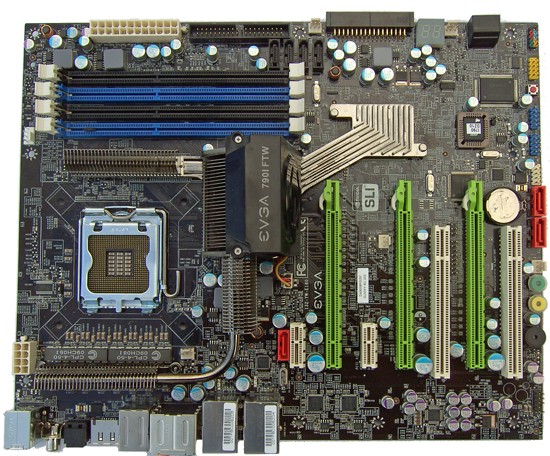 |
NVIDIA's layout is just about as good as it gets with a board crammed to the nines with expansion slots. During testing, we found most of what we needed to use was easily accessible. Cooling-wise, there are six fan headers onboard, two of which are dedicated to CPU and MCH cooling leaving you with four to populate as required. EVGA chose to go with solid polymer capacitors in all locations for power supply decoupling. These provide low ESR and the potential for a longer life than conventional 85C rated electrolytic capacitors.
MCH cooling is provided by a heatpipe and extruded sink that stretches from the Northbridge to the Southbridge. The PWM area is linked to the Northbridge via a heatpipe, while an additional heatpipe extends to a smaller heatsink to the right of the CPU socket to aid in thermal dissipation. The Northbridge sink comes with a screw-mounted fan attached to the nearby header. We found the stock cooling solution provides reasonable thermal performance for moderate overclocking. If you're going to push the SPP past 1.4V, we'd recommend you place a fan to blow over the PWM or use an additional heatsink to help lower temperatures.
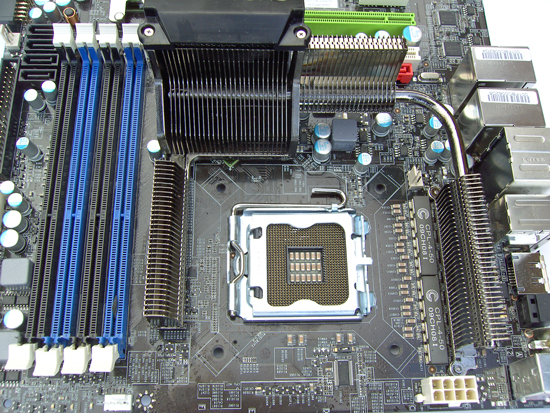 |
Here's the main selling point of this board, a clean socket area that many who use alternative cooling methods adore. Personally, we've grown to have a love/hate relationship with Volterra's PWM solutions in the past. This is mainly because early renditions of this "electronically superior" solution had implementation issues in the cooling department. However, motherboards like the Foxconn Black Ops blew our convictions wide open with its ability to soak up punishment from a quad-core processor running 100% load tests with 1.8Vcore at 5.4GHz.
Although we get a similar 8-phase solution here on the EVGA board, we also get the smaller sibling MOSFETS that have a lower overall current handling capacity. We've seen these particular MOSFETS on DFI boards in the past, where we also experienced some board deaths due to improper heatsink retention (although this has now been improved). EVGA uses a fairly firm screw mounting system and based upon the results we've seen at the top of Futuremark's Orb, everything is working as it should be to provide more overclocking overhead than conventional PWM controller solutions. The EPS12V connector is located in the usual top right corner where removal and insertion of power leads is fairly easy.
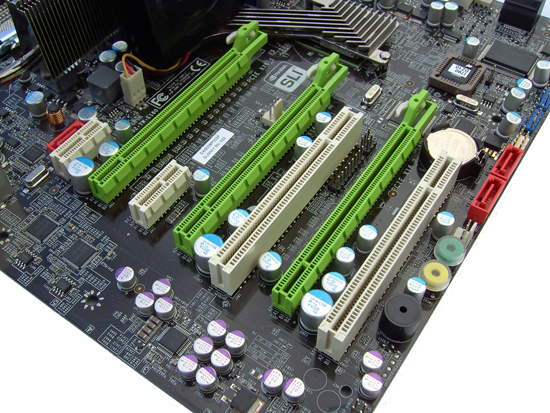 |
Another "selling point" of the FTW variant is its three full x16 speed PCI-E slots, providing triple-SLI full bandwidth to strut its stuff. PCI-E x1 slots straddle the top PEG slot and we get an additional SATA port right at the top of the tree. Front panel audio and S/PDIF connectors are placed between the top PCI slot and the last 16x PCI-E slot. You will lose access to both PCI slots if you are one of the rare individuals that runs triple SLI.
The onboard speaker, power/reset buttons, two SATA ports, and remaining front panel, USB connectors, serial connector, and CMOS clear buttons are also placed along the length of the lower edge of the board. Most of these connectors will remain as accessible as they need to be when the board is mounted inside a PC case. A welcome addition is a standard socket-mounted BIOS chip, which allows for an easy swap out should the BIOS become corrupt.
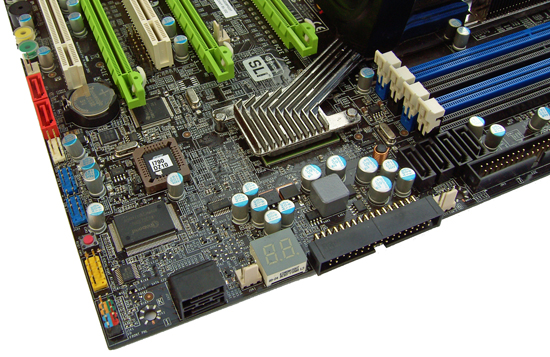 |
Moving over to the lower right of the board we find two more SATA ports placed at a 90 degree angle. The hex code LCD display sits further up, with the floppy drive connector for a neighbor.
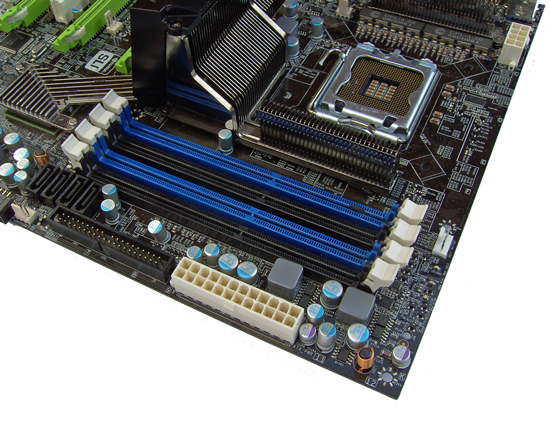 |
Memory slots are well placed enough not to hinder graphics card removal, and we also like the placement of the last four SATA ports that provide easy access regardless of how the PCI-E ports are populated. ATX12V has enough clearance too.
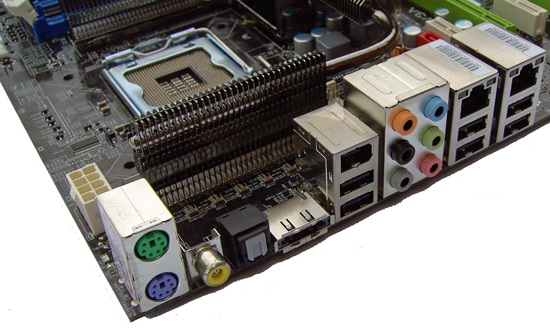 |
Finally, we move onto the rear panel. We get the standard PS/2 mouse and keyboard inputs together with S/PDIF and TOSLINK digital connectors. eSATA and FireWire ports are also present alongside the 8-channel 3.5mm connector hub. Six USB connectors are available for use on the rear panel and two RJ45 LAN connectors round off the connector saga.
Testbed Setup
| EVGA 790i FTW Overclocking / Benchmark Testbed | |
| Processors | Intel Core 2 Extreme QX9650 (Quad-core, 3.0GHz, 2x6MB cache, 9x Multiplier, 1333FSB) Intel Core 2 E8500 (Dual-core, 3.16GHz, 6MB cache, 9.5x Multiplier, 1333FSB) |
| CPU Voltage | Various |
| Cooling | Dtek Fuzion CPU cooler, 2 x PA120.2 Radiators, 3X Noctua NF-P12 120MM fans, DDC Ultra with Petra top. Dual Cascade cooling 2x1.5HP rotary comrpessors |
| Power Supply | PCP1200W |
| Memory | Corsair XMS3-2133 2x1GB (ver 4.1), Corsair XMS3-1600 2x2GB (ver 4.1). OCZ Platinum 1800 2X1GB (Early release) |
| Memory Settings | Various |
| Video Cards | ASUS 8800 GTS 512MB + EVGA & Foxconn GTX 280 |
| Video Drivers | Nvidia 169.28 & 180.43 (Beta) |
| Hard Drive | Western Digital 7200RPM 250GB SATA 3/Gbps 16MB Buffer |
| Optical Drives | Plextor PX-B900A, Toshiba SD-H802A |
| Case | Open Test Bed - Dimastech Benching Station, Lian-Li V2110 |
| BIOS | OC Test 2 & SZ15 |
| Operating System | Vista 64-bit |
| . | |
Both high-resolution 1920x1200 and 1280x1024 resolution game benchmarks were run to find performance benefits for gamers, should such advancements through BIOS tweaking exist. We utilize new drive images on each board in order to minimize any potential driver conflicts. We run each benchmark five times, throw out the two low and high scores, and report the remaining score.
Reviews of several 790i, P45, and X48 boards have allowed us to compile benchmark results for comparative purposes. Some of these boards are no longer in the test labs, so we resorted to using older graphics drivers to give us the chance to look at single card results from four different chipsets running either DDR3 or DDR2 memory. It's no surprise that things will be close, as most of us already know that memory bandwidth and speed typically only makes a 1-3% difference between DDR2 and DDR3 boards.
Everest Memory Benchmark
While not truly indicative of real world performance, Everest's memory performance tool is widely recognized as a bona-fide benchmark for gauging the effects of memory and chipset performance tuning. We lined up a number of boards under similar timing ranges to see how they compare with one another at the stock 9.5x333FSB versus tuned for best stable performance at 500FSB.
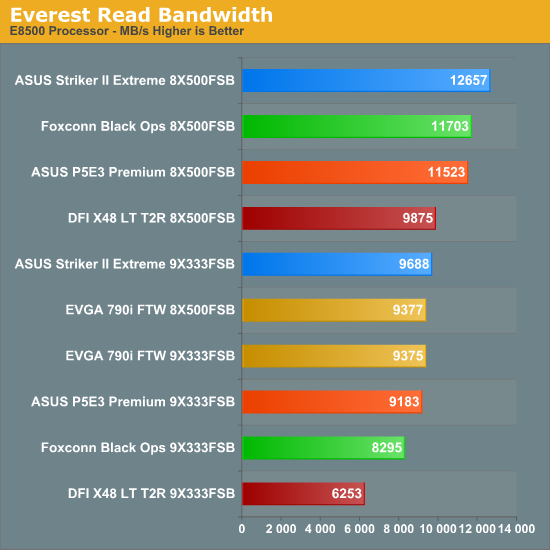
Here's the first big surprise, the EVGA 790i FTW trails ASUS' rendition of the same chipset. Considering NVIDIA knows more about the 790i than anyone else, the performance at 500FSB being so far adrift of what this chipset can really do is unexpected. We did try enabling both P1 and P2 performance registers but found that the board would only boot with P2 enabled or with both P1 and P2 disabled.
As you can see below, with the exception of write bandwidth that is still below par, the rest of the figures suggest that something is amiss...
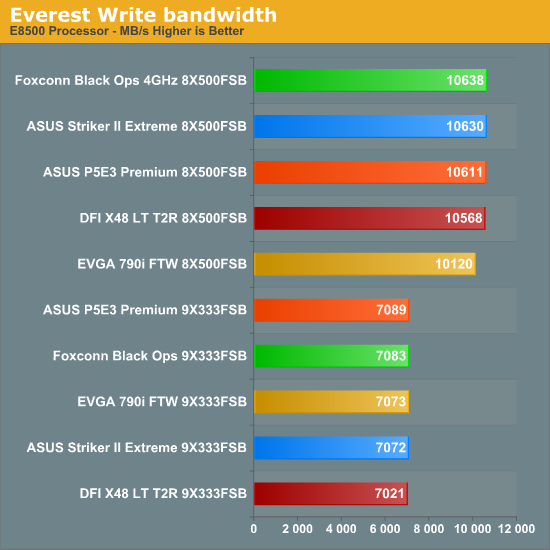
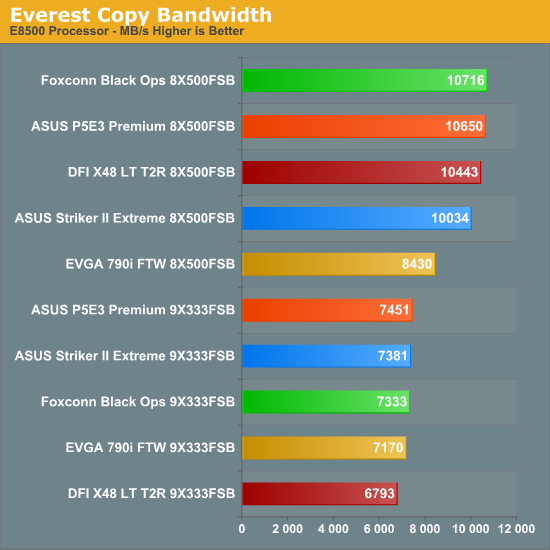
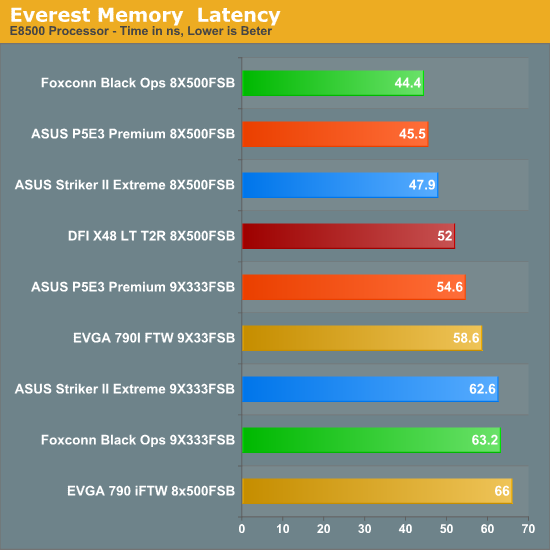
Standard Performance Results
Futuremark's PCMark Vantage is probably the single most diverse set of benchmarks that can be run on a system to mimic real world usage scenarios. The TV and Movies, Gaming, and Music Suites can be frighteningly difficult to pass when a system is overclocked. We've had boards in the labs that will pass hours of Prim95 torture test or OCCT that fail even the basic 30 minute run of PCMark Vantage, let alone the full 1 hour and 30 minutes test run. We used similar components for both stock 9.5x333FSB and absolute maximum stable settings at 8x500FSB to see how the EVGA 790i FTW compares to the ASUS P5E3 Premium, Biostar TPower I45 (DDR2), and the Foxconn Black Ops.
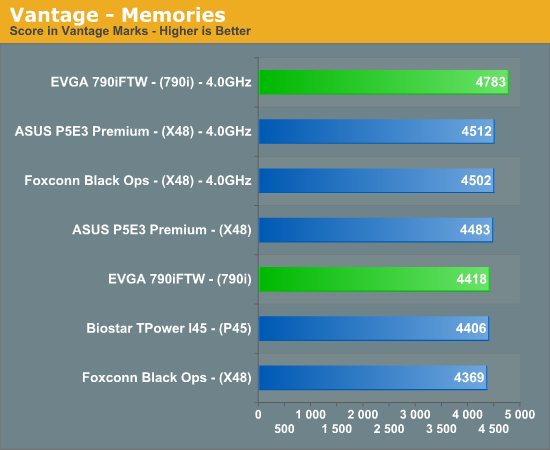
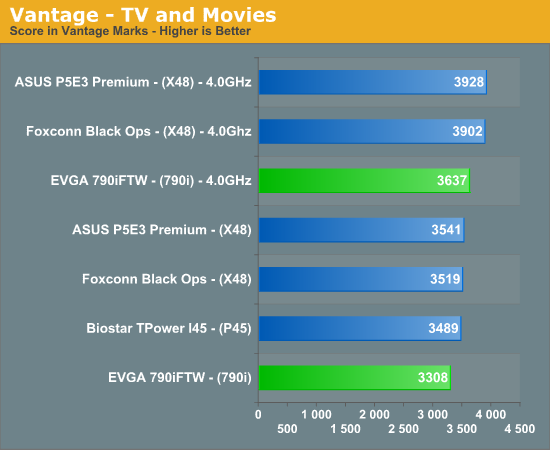
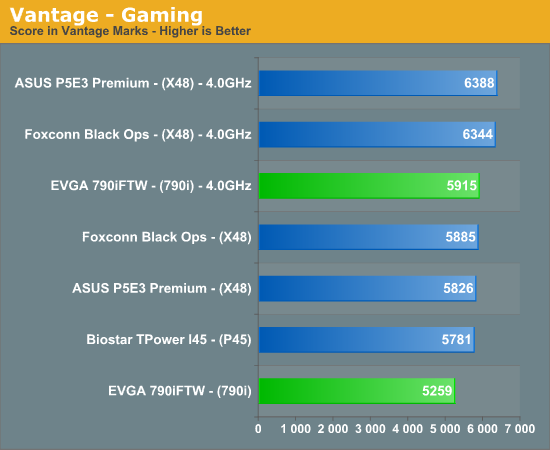
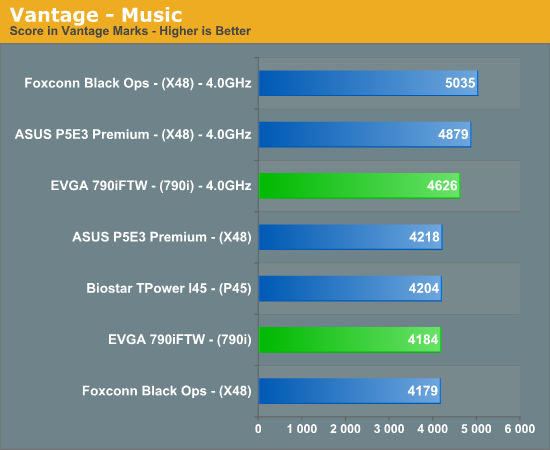
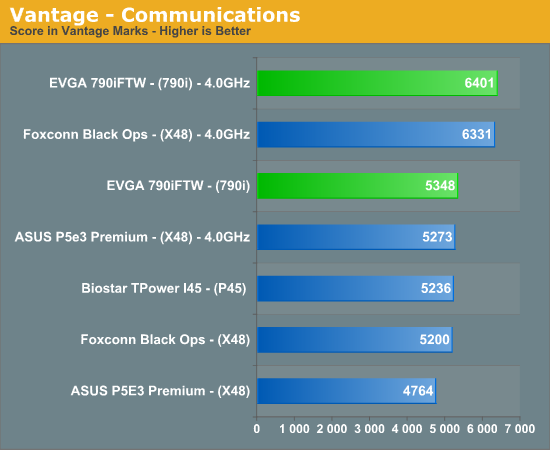
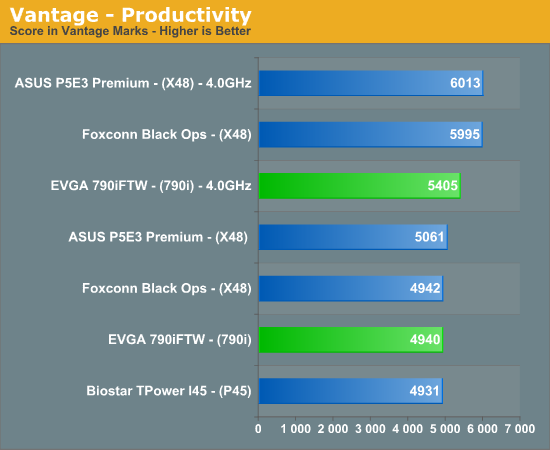
The EVGA 790iFTW strongest performance comes in the Gaming test suite, which is typical for an NVIDIA chipset. However, we find the EVGA board being an average performer in the balance of the test suites. The real world effects of the deficits seen here are hardly noticeable but go a long way when it comes to convincing users that what they are getting for their money is an outright winner. The other major problem in this regard is that we had real issues getting the board to run at 500FSB consistently.
We also lost an OS install through SATA drive corruption. We were only using 2x1GB of memory running at CAS 8-8-8-25 2T, which is within expectations of boards in this price range. On our system, the boot folder and BCD file both went missing after we rebooted the board. Unfortunately, although Vista 64-bit does attempt a boot folder/file repair, the corruption is such that you have no option but to re-install Vista completely or to use a backup image. Considering we were only using a single drive and not onboard RAID, this is a little concerning to say the least. We'd recommend users avoid high memory speeds (in excess of 1800MHz or so) on boards that will be used as workstations for everyday tasks.
Crysis Benchmark
The Crysis graphics engine remains the standard by which all new games, 3D engines, and graphics cards are judged. Highly detailed environments present massive loads to the PCI-E lanes and saturate the MCH and memory banks with a flood of data. Any system weakness or instability is often uncovered within the first loop of the Assault Demo.
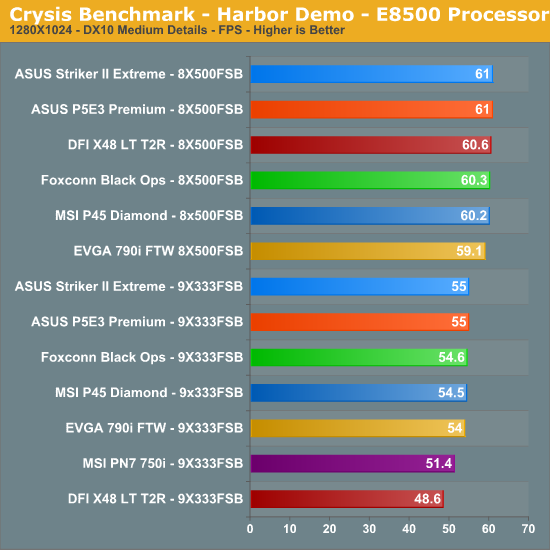
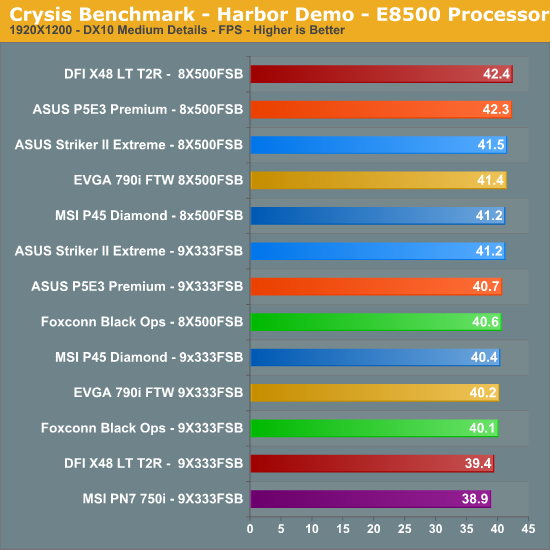
UT3 Benchmark
The highly addictive Unreal Tournament 3 remains a favorite lab game to unwind from the rigors of putting products through their paces. The UT3 engine is highly sensitive to memory access latency, often showing gains favoring a tighter performance level (tRD) setting over outright FSB speeds. A fun and frantic online playing experience demands smooth frame rates with no slowdown under load. We chose to run the Coret_Fly demo due to its back-to-back performance consistency between runs.
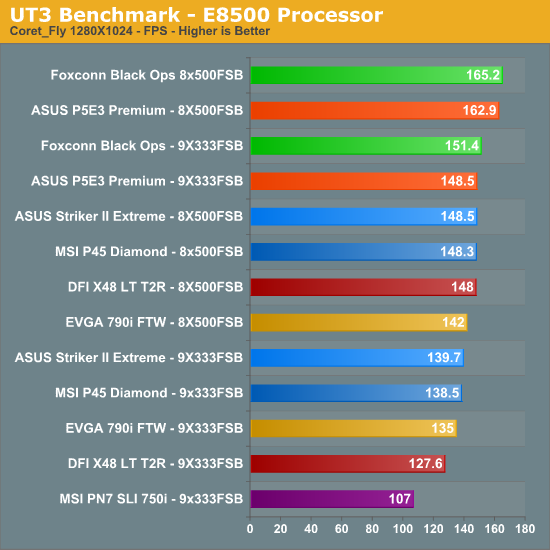
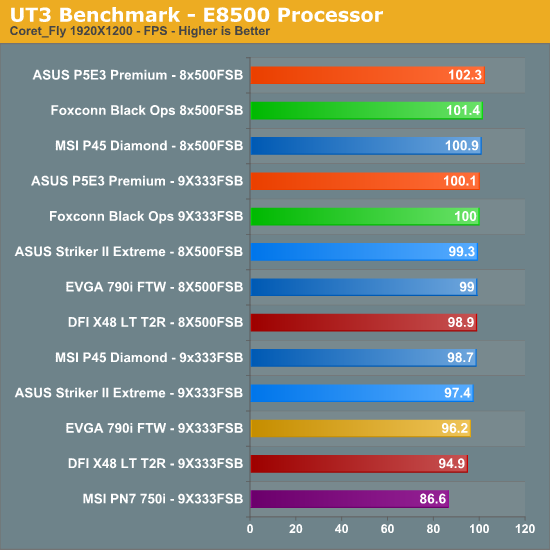
Once again the 790i FTW fails to dominate other boards when it comes to standard single GPU performance. However, it's unlikely that users will be purchasing this board for single graphics card systems. Therefore we decided to strap a couple of GTX 280s into the board to see what is on show when we max out the Crysis graphical settings in SLI to see if playable frame rates are acceptable at 1920X1200 for those who have the money to burn.
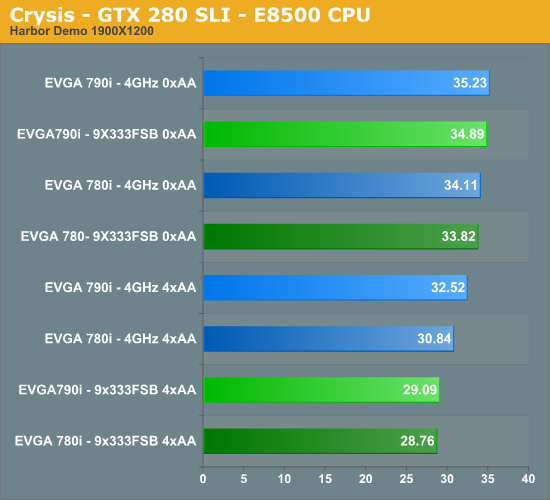
4GHz with two GTX 280s in SLI will get you an average frame rate over 30fps, although you'll probably see some in game dips to around 15fps - still not what we'd call completely playable at maximum detail levels.
Overclocking results
The 790i FTW was truly a mixed bag for us. We did not manage to find any real consistency when running the board above stock settings. We tried three different BIOS revisions; each presented us with a series of quirks ranging from the infamous FSB holes to voltage irregularities. We also managed to lose two OS installations in the process of overclocking. If you do intend to push the board, do yourself a favor and either make a complete drive image or stick to using a "medieval" IDE hard drive.
We also had to resort to using 1GB memory modules for most of our testing. Our 2x2GB Corsair XMS3 1600MHz kit was limited by the FSB holes present in the current BIOS releases. This led to us staying under 400FSB or shooting over 460FSB to get the board to boot. The Corsair kit can run at 1800 stable on other boards and probably on capable 790i boards too. In this instance, the FTW's FSB boot up requirements pushed the modules was outside their capabilities, so we never got to run any form of stability testing near 1800MHz.
On a more positive note, we did manage to scrape out a run of Crysis with an E8500 at 545FSB at 1280X1024 resolution, but the board would not pass a test run at 1920X1200.
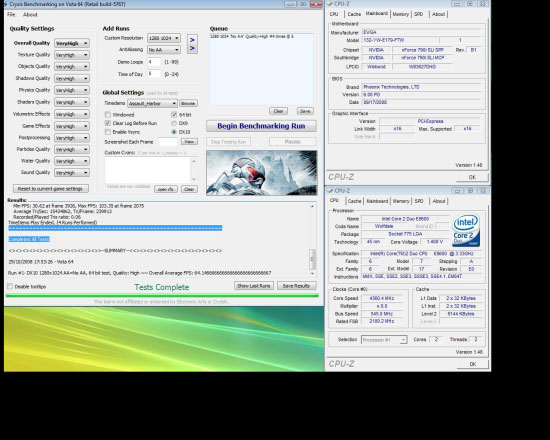 |
We tried going over to 550FSB with the memory running at 1800MHz, but once again lost our OS installation. 545FSB was more or less our benchmarking limit with water-cooling and we managed to scrape out a run of 3DMark05 without any problems.
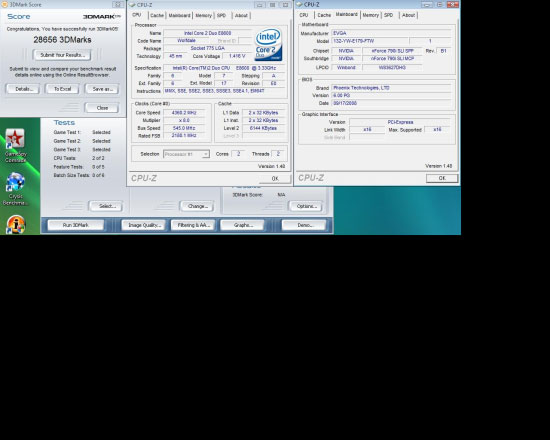 |
Where's the Subzero Stuff?
Unfortunately, our board would not cooperate when we strapped a cascade to the CPU. The problem was that the board refused to boot any time we moved away from stock settings. We had to clear the CMOS by removing the battery and shorting the clear jumpers near the BIOS chip. The board would then boot back up at stock defaults, even with the cascade idling at -118C (so it's not a cold board bug).
The 790i FTW is still on the test bench and we are prepared to give it another spin if EVGA can send us an improved BIOS. It would have been interesting to run some single and dual GTX 280 cards with this board and our QX9650, but we found that getting things to work with subzero cooling proved to be impossible. This review was delayed while we tried in vain to get to the crux of what was wrong. In the end, we made a decision to go with what we have, so people who are thinking of purchasing the board know what they're getting into if they take the plunge right now.
Conclusion
It was a brave move by EVGA to launch this board so close to the enthusiast release of Nehalem, knowing that SLI is no longer going to be limited to NVIDIA chipsets. In order to stand any chance of real success, the 790i FTW needed to come out of the blocks firing on all 12 cylinders. Instead, the current BIOS releases give you something that randomly misfires on a simple reboot and quite often ends up running on three cylinders.
Here's the lowdown. If you bench LN2 and change boards quicker than you change your underwear, be prepared to skip a change or two as you'll need to put in some extra time to get some benchmarks with the board in its current state. Such a sacrifice may be worthwhile too, as the FTW currently holds a few Futuremark world records, so there's a chance your perseverance may pay off, especially if you hard mod the board as others have done.
If SLI is "must have" status for you and you're thinking of using the 790i FTW in an everyday overclocked system, we'd advise you to go with the mature 790i Ultra instead. This is especially the case if you have a locked multiplier CPU that needs FSB overhead to overclock to a moderate or extreme degree. Everyday systems demand a board and BIOS that is stable under load and predictable on a daily basis, and we feel there are other boards out there that are far more accomplished in this regard.
While we're on the subject of dual graphics card use, we see no reason to overlook the "lesser" 750i chipset boards either. The 750i can do everything most of us need, with the added advantage of a lower price in comparison to the $300+ the FTW variant will currently cost you.
That leaves the 790i FTW with its final ace of triple SLI in full x16 glory, which is no doubt a powerful proposition. Mind you, those inclined for such expenditure are probably waiting to see what Nehalem can do, thus closing another potential sales angle for the 790i FTW.
For now, we know EVGA are working hard to resolve ongoing issues, and they have often proven themselves to be worth the price of admission by providing excellent long-term support on products. However, we still feel you'd be best advised not to take a leap of faith on the 790i FTW until they've got the basics right.







